- Joined
- May 1, 2016
- Messages
- 2,380
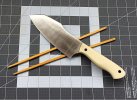 disclaimer: I am not a professional chef, but I’ve worked in several commercial kitchens. That’s called being a “Cook”
disclaimer: I am not a professional chef, but I’ve worked in several commercial kitchens. That’s called being a “Cook”The Look: Ivory G10 with black micarta liners, one forward pin and one aft lanyard loop. Chris’s distinct departure from a classic santuko design is dramatically evident. I'm not sure what he would call it on this Santuko, but I’ve seen this referred to as a “poon tip” on various other knives. I like this look a lot and my friends in the food business give it plenty of “ooooohs and aaaaahs”
Steel: CPM154 [3/32] tapered tang
and full height convex grind on 3/32”. As Chris puts it .."No plunge lines, all blended together"
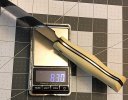
Weight: a stout 8.3oz compared to 5.8oz with my Wüsthof chefs knife.
I didn’t take a photo to show it’s center point, but as it always is with Chris’s work, it’s spot on where it needs to be.
The Length: Just a hair under 10.75in.

The Feel: First, the G10 scales with Chris's treatment of sand/glass beading and then soaking with WD40 make for excellent grip retention. This is especially important when processing animal proteins. It is slightly, but for me noticeably heavier than any of my other knives in my roll. This is the knife telling me to pay close attention to what is in my hand and especially to what I am doing. I say this because I have some much lighter knives equally SAF that I've cut myself with. My Bad,.. but none the less I do pay close attention when I'm using the OK&T Santuko. I haven't had the opportunity to do any extended [3-4 hours] kitchen prep work in awhile so the jury is out as t whether or not the extra weight makes any difference in a 4 hour stretch. I do not believe it would but I'll definitely find out this summer. Suffice to say I'm still IN the learning curve.
The following is a [paraphrased] excerpt of a recent conversation with Chris.
Chris: “ How has the Santuko been treating you?“
Me: “It’s been quite the experience. Both informing and counter intuitive at the same time. Over the years I’ve developed a particular muscle memory for using the same conventional 8 to 10” chefs knives, and the classic Santuko knives day in and day out. While it’s weight tricks my mind into thinking it might be too heavy or thick for some tasks. I’ve been surprised over and over again at what this knife can do even when a particular task calls for a thinner blade. Say like cutting tomatoes in thin slices.”
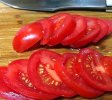
Me: “Even as the blade appears to be too thick looking down from the spine. The grind you managed to put on it fools the eye but absolutely will do thin cuts.
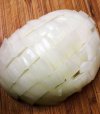
Sure a thinner blade with a flatter cutting edge will do a great job. Your Santuko will do nearly the same job for thin blade use but will also cut of animal protein, as expected obviously, better than any other kitchen blade I have.”
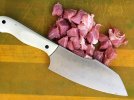
Chris: Do you feel there could be any improvements made on the knife?
Me: Two things come to mind for me in particular. #1 I use a pinch grip, as does most anyone who works daily doing food prep with both dense and soft vegetables. A rounded spine just off the handle by a couple of inches would be a comfort.

#2 Also regarding my use of a pinch grip, a little more forward clearance at the choil would keep my index finger safe would also be helpful.
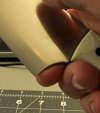
Final thoughts: This thing is such a pleasure to use... And there was/is definitely a learning curve, as would be expected with any new blade. Ive learned a lot about knives in the last three years; likes, dislikes, aesthetics, different steel, different grinds, different configurations for different uses. That said I still don’t feel like I know much. What I do know is that Chris Linton’s interpretation of a Santuko is a very, very good one.

Last edited:
